New Report finds Los Angeles Garment Factories Are Dusty, Dirty, and Dangerous
New Report finds Los Angeles Garment Factories Are Dusty, Dirty, and Dangerous
The study provides insights into the health and safety conditions of LA’s garment industry
LOS ANGELES- In collaboration with the Garment Worker Center and UCLA Occupational Safety and Health (UCLA LOSH), the UCLA Labor Center just released, Dirty Threads, Dangerous Factories: Health and Safety in Los Angeles’ Fashion Industry. This new report, the first of its kind, provides insights into the health, safety and environmental conditions of the garment manufacturing industry.
According to the report, factories are dusty, hot, and poorly ventilated. 72% of surveyed workers indicated that their factories are brimming with dust. During focus group sessions, many expressed concern for their health given the dust and workers commonly have to find their own protective methods. Furthermore, workers complained of burning, teary eyes and compromised vision given long hours of exposure to these conditions.
In addition to dust, garment workers unsanitary factories, 42% indicated that they had seen mice and rats at their workplaces. 47% also reported that workplace bathrooms were soiled and unmaintained. “Our findings demonstrate a persistent absence of pest control and sanitary maintenance that would mitigate and eliminate the infestation of disease-carrying pests in garment factories in Los Angeles,” explained Janna Shadduck-Hernandez, report co-author and Project Director at the UCLA Labor Center, “retailers should be held responsible not only for wage and hour violations but also for these unsafe and unhealthy work conditions.”
The study also identified unsafe and dangerous working conditions garment workers. 42% of workers reported that exits and doors at their shops were regularly closed and 49% indicated that there were no first aid kits available on site. Furthermore, garment workers expressed concerns about how their work will impact their long-term health. They described the toll of years of prolonged sitting in ungainly postures and podiatric pain so severe they could barely walk home from work at the end of the day. “On average, I would work for about 11-12 hours sitting down with my sight heavily focused on the jeans. The chairs we used for work were your typical fold up metal ones and because of the way the jean pockets were stitched on, we would sit pretty crooked to produce clothes faster. I’m 100% certain this is why body is messed up,” explained Reynaldo Leal, a local garment worker who is in the middle of a workers compensation case.
Report authors recommend new citywide standards to fill gaps in worker protections, implementation and oversight of indoor heat standards for all indoor workers in California, and end to the piece rate system that many factories implement to incentivize workers to work faster.
“The piece rate system that compels employees to work as quickly as physically yet it is the reason many of the workers I’ve met have incurred injuries and also wage hour violations,” explained Zacil Pech, report co-Author and Health and Safety Organizer at the Garment Worker Center. The report was based upon 307 surveys with garment workers and several focus group discussions in 2015. Every worker surveyed was employed in a Los Angeles-based apparel manufacturing shop at the time of inquiry.
Download full report here: http://bit.ly/garmentworker
**Please contact Citlalli Chávez to schedule interviews with report authors and local garment workers.**


